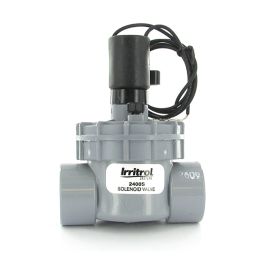From input in other threads regarding where to locate a camera(s) at a gate and on connecting a camera PoE switch from around 330-plus feet away, the cameras grew to seven, and it is clear that the long run network connection should be fiber optic. The existing buried conduit is ¾”, which is limiting. Additional conduit runs could become feasible by making a project planned for later happen sooner. I’ve been thinking about an irrigation project which involves trenching for water supply lines. Once you have trenches, it is a matter of more PVC conduit for camera related cable.
1. For the 330 foot run, what size conduit should I install in the ground? If 1” schedule 40 conduit is $X/foot, 1½” is 2X, and 2” is 3X, approximately speaking. I’m thinking of one conduit for the FO cable, and a second one for other TBD future use. 1” water line also in the same trench. The trenching machine makes a 6” trench in the ground.
2. Can copper ethernet cable be run in the same conduit as 24V irrigation valve control wires? The irrigation controller that energizes the control wires has a transformer that is specified as: “Transformer output (24 VAC): 1 A”
Since there will be trenching for water lines, I’m going to put irrigation solenoid valve control wires in conduit, rather than direct bury the wires. Control wires for irrigation are 18 AWG and carry 24V to operate the solenoid valves. For irrigation typically only one zone runs at one time because water is the constraint, though in any case the transformer output (above) is limited.
With all this trenching, it may be feasible to expand the reach of future camera locations by having a conduit in the ground on three sides of my house. Approximately half the distance would have irrigation control wires (in conduit) anyways, and I’d be adding conduit where there will anyways be trenching for water lines. So incremental cost will be conduit. Disadvantage of buried conduits is that I’ll have to use burial grade ethernet cable in the future.
Alternatives could be don’t run network wires in ground or install dedicated camera-cable-only conduit in the ground.
Request input.
1. For the 330 foot run, what size conduit should I install in the ground? If 1” schedule 40 conduit is $X/foot, 1½” is 2X, and 2” is 3X, approximately speaking. I’m thinking of one conduit for the FO cable, and a second one for other TBD future use. 1” water line also in the same trench. The trenching machine makes a 6” trench in the ground.
2. Can copper ethernet cable be run in the same conduit as 24V irrigation valve control wires? The irrigation controller that energizes the control wires has a transformer that is specified as: “Transformer output (24 VAC): 1 A”
Since there will be trenching for water lines, I’m going to put irrigation solenoid valve control wires in conduit, rather than direct bury the wires. Control wires for irrigation are 18 AWG and carry 24V to operate the solenoid valves. For irrigation typically only one zone runs at one time because water is the constraint, though in any case the transformer output (above) is limited.
With all this trenching, it may be feasible to expand the reach of future camera locations by having a conduit in the ground on three sides of my house. Approximately half the distance would have irrigation control wires (in conduit) anyways, and I’d be adding conduit where there will anyways be trenching for water lines. So incremental cost will be conduit. Disadvantage of buried conduits is that I’ll have to use burial grade ethernet cable in the future.
Alternatives could be don’t run network wires in ground or install dedicated camera-cable-only conduit in the ground.
Request input.



